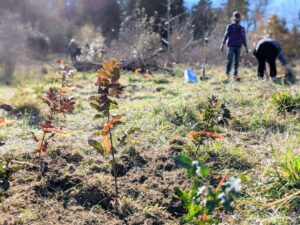Tag: Green Space Initiative
Friends of Trees, Friends of Bees
How we can plant to promote native pollinators
Next time you see a bee buzzing around your garden, take a closer look. It’s cute, right? And on top of that, it’s performing a very important ecological process—pollination!
Last month we hosted two pollinator workshops in Washington county during National Pollinator Week, thanks to funding from the Tualatin Soil and Water Conservation District. Folks gathered at the PCC Rock Creek Learning Garden and at Tualatin River National Wildlife Refuge to take a tour of pollinator-friendly plants, learn what makes for good pollinator habitat, and to spot some native bees along the way. Friends of Trees staff shared their knowledge on the topic and led activities to guide people in designing their own pollinator gardens.
What is a pollinator? Pollinators are animals (mostly insects) that move pollen from a flower’s male part to its female part in their search for sustenance, making that plant’s reproduction possible. This process makes pollinators a really key part of both agricultural and ecological systems. 35% of our food sources and 75% of flowering plants depend on pollinators.
“Unfortunately, we’re seeing a massive, unprecedented decline in native bees and other pollinators,” says Thomas Meinzen, a Neighborhood Trees Specialist at Friend of Trees who studied pollinator ecology and conservation in graduate school. In some countries, studies have shown more than 75% decline in insect biomass in 30 years. Because pollinators are relatively understudied, the impacts and ramifications of this decline are not fully understood.
“There are a lot of contributing factors, including pesticide and herbicide use, grazing practices, agricultural monocultures, habitat loss and climate change,” Thomas says. “It’s scary, but there are still things we can do.”

IN OUR OWN BACKYARDS
We can create habitat in our own backyards and parks. Luckily, we don’t need entire wilderness areas for pollinators to live in. You can help by planting a variety of flowering plants to provide food for pollinators from spring all the way into fall.
“Trees are particularly helpful here because they flower earlier in the year than most smaller flowering plants, providing food for early-season pollinators like bumble bees,” Thomas says. “Trees like California buckeye, cascara, hawthorns, willows, and fruit trees are all great options for native pollinators.”
It’s also best to cultivate a diversity of flower shapes, colors, and types to attract a diverse array of pollinators. Bees, butterflies, and flies are all pollinating insects looking for different types of food.
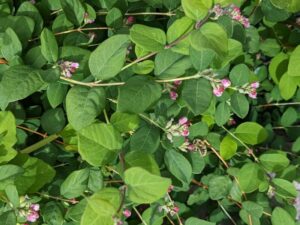
NATIVE PLANTS FOR NATIVE POLLINATORS
It makes sense that native pollinators are attracted to native plants. Our Green Space program enhances natural areas by planting many thousands of native shrubs and plants each planting season, improving air and water quality and creating habitat for wildlife, including pollinators.
“A lot of our Green Space plantings are designed to improve water quality in particular,” says Kaitie, a Green Space specialist. “But these plants are great for pollinators, which is more than just an added bonus.”
Plants like red-flowering currant and Oregon grape are common at our Green Space plantings and favorites for pollinators. Our Green Space plantings also leave open ground where bees can nest.
Many people express concern for honeybees, not realizing that honeybees come from Europe and can potentially outcompete native bee species. There are over 4,000 native bee species in the United States and over 650 in Oregon.
“There’s a lot of growing interest in pollinators,” Thomas says. “It was exciting to see that at our pollinator workshops with great turnout, in-depth conversations, and the chance to send folks home with pollinator plants.”
The best things we can do to protect and promote native pollinators are to avoid using pesticides and herbicides on our properties, plant flowers and native plants, and leave things a little messy so that pollinators can make themselves at home in our gardens.
Wilkes Creek – Connecting a Community
New funding will develop the Wilkes Creek Headwaters into an accessible natural area
For three planting seasons, Friends of Trees volunteers have been enhancing the natural area at the Wilkes Creek Headwaters in outer East Portland. The 20.7-acre hybrid park is nestled in the neighborhood, and provides opportunities for local residents to connect with nature. The site was jointly purchased by Portland Parks & Recreation, the Bureau of Environmental Services, and Metro in 2011, and it will be preserved and enhanced as a public space for generations to come.
The natural area is particularly special because it is home to the headwaters of Wilkes Creek, which flows into the Columbia Slough. Just past the planting site, you can see the natural springs where water comes to the surface and turns into a stream.
“The headwaters can be seen bubbling up from the earth near the midway point of the property,” says Maija Spencer, Senior Community Engagement Coordinator for Portland Parks & Recreation. “Forty bird species, coyotes, and the Stumptown scud—a freshwater crustacean found only in the Portland area—call the property home.”
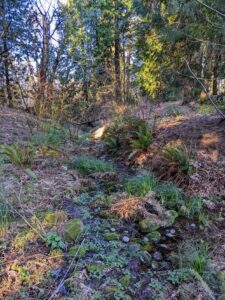
“Wilkes Creek is one of the only remaining free-flowing above-ground streams that makes its way into the Columbia Slough,” says Yoko Silk, a Stewardship Coordinator with PP&R. “There used to be hundreds, now there’s only a handful. So it’s really special for being that source of cold, clean water into the slough. And it provides a really important habitat to all sorts of critters.”
Friends of Trees volunteers have planted native plants throughout the central part of the park as part of the Greening Wilkes Initiative. There’s a wildflower meadow, where they’ve put in thousands of camas, checker mallow, lupine, yarrow, goldenrod, and many more. On the hillside, below an old hazelnut orchard, they have planted shrubs and small-form trees like serviceberry, Oregon grape, snowberry, and oceanspray.
“We want visitors to feel transported,” says Green Space Senior Specialist Harrison Layer. “We’re preserving this natural space as a beacon for birds flying overhead, and wildlife on the ground.”
Wilkes Creek Headwaters has received 8 million dollars in funding for its preservation and development through Portland Parks and Recreation. This park is considered a hybrid space because it’s being enhanced as a natural area at the same time it’s being developed into a usable park with benches, trails, and educational signage. In addition to providing the community with more access to green spaces, developing trails and signage will help protect the natural area that the community has worked so hard to develop.
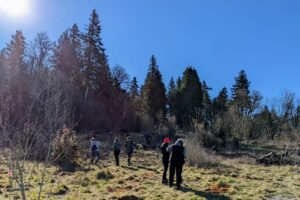
“Portland Parks & Recreation will collaborate with partners and community members to create a plan for developing the park, with a focus on including the voices of Native and Indigenous communities and communities of color,” Maija says. “The goal is to enhance the park’s natural features, while also providing more recreational opportunities and access to nature for East Portland residents.”
“This is an important park because of its location in East Portland, an area that has less park space and opportunities to connect with nature,” Harrison says. “It also shows the connectivity that a creek can bring to a community. It starts at the park, moves through neighborhoods and industrial space, and eventually flows into the slough. Protecting this area will help protect the Columbia Slough as a whole.”
The Greening Wilkes Initiative incorporates a layered approach to community engagement. Community organizations have joined together in the collaborative effort to enhance and diversify green spaces throughout the neighborhood around Wilkes City Park and Wilkes Creek Headwaters in outer East Portland. Friends of Trees, Portland Audubon, Verde, Columbia Slough Watershed Council, and Portland Parks & Recreation each provide their unique and complementary approaches to community engagement around important natural resources in the Wilkes community.
“I’ve had community members tell me that they didn’t even realize that this natural spring was here,” says Harrison Layer, our Green Space Specialist who leads Wilkes Creek plantings. “It’s really special to share it with them.”
You are invited to join in shaping the future of this special place by joining the email list and applying for the project advisory committee. More info can be found here.
Join us this Saturday to help restore the Tualatin River Basin
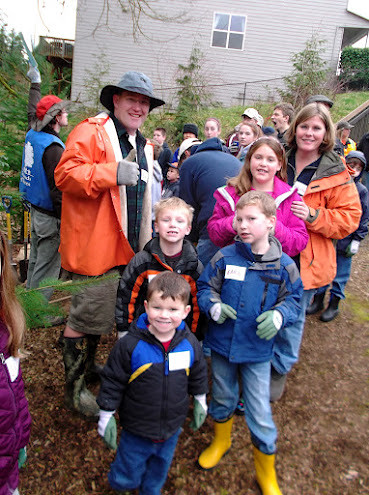
Friends of Trees is excited to partner with Clean Water Services and the City of Tualatin again this year to help CWS reach its Tree for All goal of planting two million trees in the Tualatin River Basin. This Saturday we’ll add 800 native trees and shrubs along Nyberg Creek, upstream from the 13-acre Nyberg Creek Preserve and the confluence area of Nyberg Creek with the Tualatin River in Brown’s Ferry Park.
Last year more than 80 volunteers joined us to plant at Ibach Park in Tualatin. We’re looking forward to another fun planting, where we’ll add cascara, red-flowering currant, Pacific ninebark, and other native plants to the river basin.
Be sure to arrive at the natural area next to Bushwhackers Saloon, 8200 SW Tonka Street, by 8:45 am so you can sign in, warm up with a hot drink, and have the best choice of donuts!
Below is a slideshow of photos taken by Keith Nevison at last Saturday’s Green Space Initiative planting in Gresham and by Logan Lauvray at our GSI planting at Forest Park. Many thanks to last weekend’s planting partners: the city of Gresham, West Multnomah Soil & Water Conservation District, Xerces Society, and Portland Parks & Recreation.
Help make Forest Park more attractive to pollinators!
By Andy Meeks
Have you ever gazed in wonder at all of the amazing trees and lush vegetation in Forest Park? Walked under the huge canopy and among the beautiful native flora and thought about how you’re still within a city? I know I have. And you can help restore key areas of Portland’s gem at our annual Forest Park plantings this November!
In conjunction with the West Multnomah Soil & Conservation District, Xerces Society and Portland Parks & Recreation, Friends of Trees is planting almost 1,100 native shrubs and flowers to increase native pollinator habitat in Forest Park and to increase awareness of the importance of native pollinators in urban areas.
These plantings will occur from 8:45 am to 1:00 pm on Saturday, Nov. 10 and Saturday, Nov. 17. Space is extremely limited, so you need to sign up in advance in order to participate. You can save your space (or spaces, if you’d like to bring your friends or family) by filling out this FOREST PARK SIGN-UP FORM.

If you have any questions or need more information, please contact Andy or Jenny in the Volunteer & Outreach Program. We hope you can join these efforts to help Forest Park maintain its magnificence!
— Meeks is the Volunteer & Outreach Program Manager with Friends of Trees and loves exploring Forest Park on foot and bicycle.
Friends of Trees Eugene to kick off planting season on Oct. 27
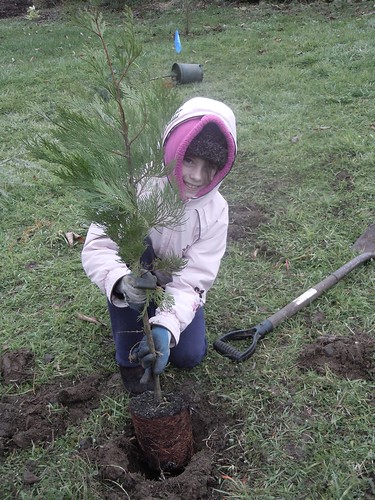
Friends of Trees Eugene will kick off the 2012-13 planting season on Saturday, Oct. 27, with a tree planting from 9:00 am to 1:00 pm at Rob Adams Park, 890 Mountaingate Drive, Springfield. The planting is the second phase of a collaboration between Friends of Trees and Willamalane Park and Recreation to restore the park. In 2011, community volunteers planted 262 trees. This year, volunteers will plant 275 native conifers.

People of all ages and abilities are encouraged to join the planting. No pre-registration is required, and gloves, tools, guidance and refreshments will be provided. Volunteers are expected from Springfield, Eugene, Friends of Trees, Willamalane Park and Recreation, and the University of Oregon.
The park is named for Rob Adams, a dedicated member of the Willamalane Board of Directors for more than 20 years, and is located in the Thurston area of Springfield.
Originally a rock quarry, the park now connects to a hiking trail and is managed by Willamalane Park and Recreation District as part of the Mountaingate development in Springfield’s southeast hills.
For more information, please call Friends of Trees’ Eugene Director Erik Burke at 541-632-3683.


